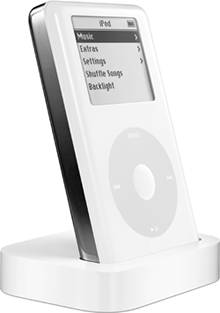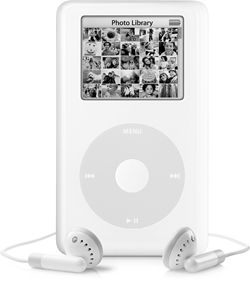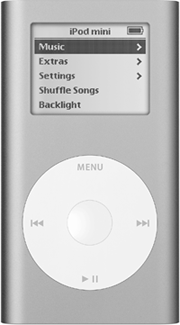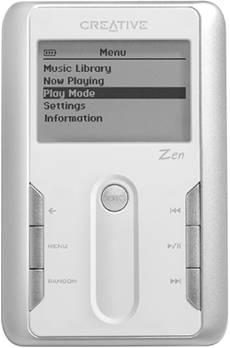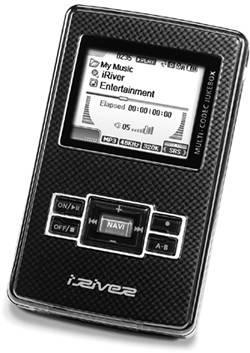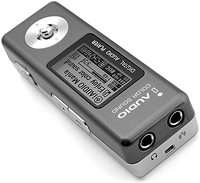Listening to Podcasts
| So now you know where to find and how to obtain your podcasts. How are you going to listen to them? Several options are available to you, depending on what software you are using. First, if you are using a program with a built-in media player, you can enjoy the podcasts on your PC using said player. If you want to use a digital music device, such as an iPod or a Nomad, you must get the podcast downloaded onto your player. There are many ways to do both, as you'll see in this section. Software-based (computer) playersFor those who like to listen to their podcasts directly on their home (or work) computers, a software-based media player is the answer. If the podcast aggregator you are using does not include a built-in media player, and you are not using a program like Apple's iTunes for Mac or PC, you will need to ensure that you have some other form of media player installed on your computer so that you can to listen to the podcasts at they arrive. Many media players are available in cyberspace. Just about every sound card ever made comes with a media player, as do most video cards, be they from Matrox, NVidia, or ATI. In fact, there are so many media players for Windows-based machines that I could write an entire book on them. Not to worry despite the vast array of media players floating around, the ubiquity (and utility) of the "big three" means that I need to discuss only those three options: Windows Media Player, RealPlayer, and QuickTime. Windows Media Player (WMP)
Operating System: Windows, Macintosh Windows Media Player is the default media player from Microsoft Corporation (Figure 2.60). Because the vast majority of home PCs run Windows software, this means that nearly everyone has Windows Media Player (or some version of it) installed. Because this software is free, updates for it can be downloaded at no cost so that users can keep up to date with the latest advances in media-player technology. Figure 2.60. The current version of Windows Media Player is available at Microsoft's Web site for free.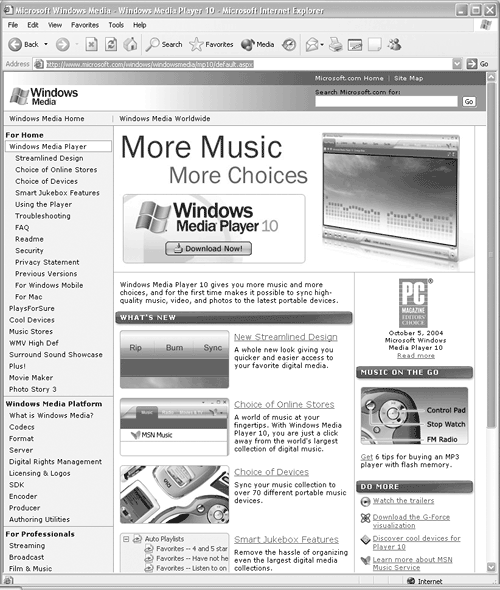 The current version of this software is Windows Media Player 10 (Figure 2.61), which is available for download at Microsoft's Web site. Windows Media Player can play MP3 files, video files, picture slide shows, and Internet radio, making it a fantastic one-stop basic media player. Of course, don't forget that WMP also plays compact discs, DVD movies, audio DVDs, and MP3 CDs. For Windows users, I recommend Windows Media Player if for no other reason than that you probably already have it on your machine. Figure 2.61. Windows Media Player 10 in action.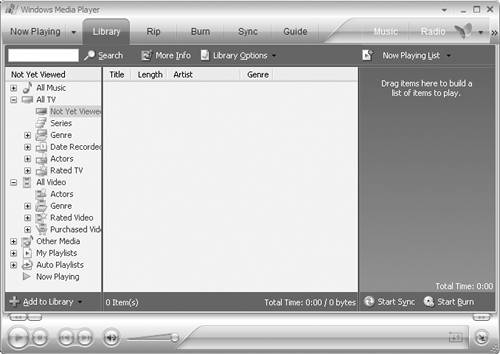
RealPlayer
Operating System: Windows, Macintosh, Unix/Linux RealPlayer (Figure 2.62) is the main cog in RealNetworks' wheel. First released in 1995, RealPlayer has long been a favorite of many users, and it arguably has driven many of the innovations in media players. The latest version of RealPlayer, Version 10.5, can play CDs, DVDs, audio DVDs, video, and audio, and also allows users to burn CDs. As a bonus, RealPlayer has a TiVo-like feature that allows you to buffer streaming content, like Internet radio broadcasts. If you dislike Windows Media Player and feel like being closer to the cutting edge, RealPlayer is a good choice. Figure 2.62. RealNetworks' RealPlayer is a very respectable media player.
QuickTime
Operating System: Macintosh, Windows The granddaddy of all media players, QuickTime (Figure 2.63) is Apple's entry into the media-player sweepstakes. Introduced in late 1991, QuickTime has evolved and constantly pushed the envelope in doing so. Today, QuickTime is the media player of choice for movie studios when they want to put their trailers out on the World Wide Web. Indeed, QuickTime boasts the highest quality of any of the media players. Figure 2.63. QuickTime is what the movie studios use when they put their trailers out on the 'net. Perhaps the biggest bonus that QuickTime offers is that it is seamlessly integrated into iTunes. Because the majority of digital music devices are iPods, it makes sense that iTunes and QuickTime will be oft-used software in the world of podcasting. The basic version of QuickTime is free (Figure 2.64), and it does everything a podcast enthusiast needs. The other main factor with QuickTime is quality, and although this is open for debate, few people will dispute that QuickTime is the hands-down winner when it comes to image and sound quality. Figure 2.64. QuickTime's dynamic Web page.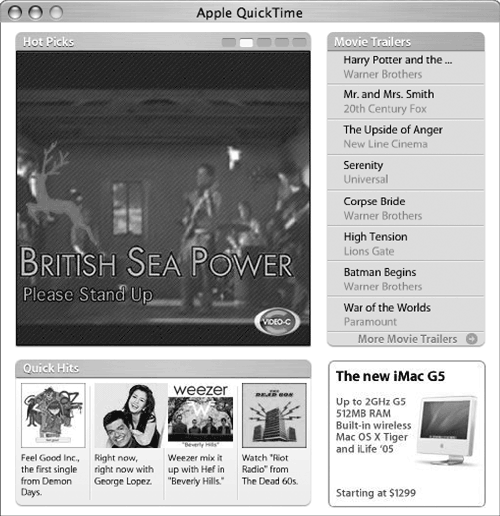 MP3 playersAlthough you can listen to podcasts on your computer, the main thrust of the podcasting movement is to make podcasts portable, allowing them to be played on iPods and other digital music devices, including SmartPhones and PDAs. There are more digital music players, SmartPhones, and PDAs on the market than you can shake a stick at, so I will stick to the top one or two in each category to give you an idea of what is out there and what the feature sets are. Before I delve into examining various digital music players, however, I need to point out the utter dominance of Apple's iPod. At this writing, the hard-drive-based iPods had more than 80 percent of the market in North America, and with the flash-memory-based iPod shuffles selling like hotcakes, it is reasonable to assume that the flash-based market will fall to Apple as well. Currently, Apple controls more than 65 percent of the total digital music player (MP3 player) market, so I'd be remiss if I didn't focus heavily on these players.
iPodPhoto courtesy of Apple Computer, Inc.
Manufacturer: Apple (www.apple.com) Price: $299 Memory Type: Hard drive Memory Size: 20 GB (5,000 songs) Weight: 5.6 ounces Screen: Yes Battery: Internal/rechargeable OS Compatibility: Macintosh, Windows This is the unit that started it all. The original 5 GB iPods, however, are long gone from store shelves, replaced by fourth-generation machines that have been refined considerably. At this writing, there is only one iPod proper for sale: the 20 GB model. The U2 Special Edition 20 GB iPod can still be had, but there is no doubt that before long, it will no longer be available. With a very easy-to-use interface that has been copied by its competition, the iPod combines impressive styling with user-friendly features that have propelled it to the top of the heap. The basic features of the iPod are:
iPod photoPhoto courtesy of Apple Computer, Inc.
Manufacturer: Apple (www.apple.com) Price: $349/$449 Memory Type: Hard drive Memory Size: 30 GB (7,500 songs)/60 GB (15,000 songs) Weight: 5.9 ounces/6.4 ounces Screen: Yes (color) Battery: Internal/rechargeable OS Compatibility: Macintosh, Windows The iPod photo is an iPod with the added benefit of a color screen and the ability to store thousands of photographs (in digital form) as well as music on the iPod's hard drive. Before you scratch your head wondering why anyone would want to combine these two things, let me point out that the ability to listen to music while a slide show of your latest vacation pictures zips by is surprisingly compelling and enjoyable. With the video/audio output cable, the iPod photo can be turned into a portable slide-show machine, displaying pictures while serenading viewers with music of the operator's choice. The iPod photo can hold up to 60 GB more than enough to store a couple hundred CDs and a few thousand of your favorite pictures. iPod miniManufacturer: Apple (www.apple.com) Price: $199/$249 Memory Type: Hard drive Memory Size: 4 GB (1,000 songs) /6 GB (1,500 songs) Weight: 3.6 ounces Screen: Yes Battery: Internal/rechargeable OS Compatibility: Macintosh, Windows Photo courtesy of Apple Computer, Inc.
The iPod mini is a hard-drive-based player with a much smaller hard drive than we have come to expect from iPods. The tradeoff is that the mini is very tiny, yet still sports the backlit iPod screen and menu system that consumers have come to love. The iPod mini is the iPod for those folks who value space above all else. Only slightly larger than a credit card (although much thicker), the iPod mini is a joy to tote around when traveling or exercising. The only limitation of the mini is its relatively small hard drive. If keeping your entire music collection on hand is important to you, the iPod mini shouldn't be your first choice. The mini, however, is the coolest digital music device, in my book. iPod shuffleManufacturer: Apple (www.apple.com) Price: $99/$149 Memory Type: Flash Memory Size: 512 MB (120 songs) /1 GB (240 songs) Weight: 0.78 ounce Screen: No Battery: Internal/rechargeable OS Compatibility: Macintosh, Windows Photo courtesy of Apple Computer, Inc.
The iPod shuffle is Apple's newest foray into the MP3 player market, and it raised a lot of eyebrows, because the iPod shuffle is a flash-memory-based player rather than a hard-drive-driven device. Add to that the fact that the shuffle doesn't have a built-in screen, and it would seem that Apple took a very big risk. Risk or no risk, upon its release, the public immediately fell in love with the iPod shuffle, and waiting lists to buy it were in the six- to eight-week range! Despite lacking a view screen, the iPod shuffle is an outstanding digital music device that is arguably smaller than a seven-stick pack of chewing gum. The shuffle has the following functions: play, rewind, fast-forward, previous song, next song, pause, volume up/down, and play songs in order or shuffle songs. Although using an MP3 player without a screen as a podcast player may seem strange, I use my iPod shuffle for just that. In iTunes, I transfer two or three podcasts to the shuffle; then it's off to the gym. I strongly recommend that you use iTunes if you are going to purchase a shuffle; only when these two products work together does the iPod shuffle really sing.
Zen TouchManufacturer: Creative (www.creative.com) Price: $250/$329 Memory Type: Hard drive Memory Size: 20 GB (10,000 songs)/40 GB (16,000 songs) Weight: 7.05 ounces Screen: Yes Battery: Internal/rechargeable OS Compatibility: Windows
Claiming 24 hours of battery life on one charge, the Creative Zen Touch is perhaps Apple's toughest competition in the hard-drive-based MP3 player market. Although Creative has a complete lineup of MP3 players, the Zen Touch is its high-end digital music player, and as such, it comes packed with a wide selection of features, including:
The Zen Touch was designed primarily to work with Windows PCs, so I recommend that only Windows users consider it when shopping for a digital music device. With both a 20 GB and 40 GB configuration, the Zen Touch is a solid digital music player with an adequate included software package. If you intend to use a Zen Touch, ensure that you have USB 2.0 on your computer; otherwise, the time it takes to transfer large numbers of files becomes prohibitive. iRiver H320Manufacturer: iRiver (www.iriver.com) Price: $299 Memory Type: Hard drive Memory Size: 20 GB (10,000 songs) Weight: 7.16 ounces Screen: Yes (color) Battery: Internal/rechargeable OS Compatibility: Windows
iRiver has a complete lineup of digital music players, but I chose to discuss the H320 because it is widely acknowledged to be a competent unit, and its price point and feature set are comparable with those of the other devices discussed in this section. Weighing in at just over 7 ounces and sporting a color screen, the H320 offers direct competition to the iPod Photo. The iRiver Web site boasts that the H320 can store up to 600 hours of music, as well as thousands of digital pictures. Available only for Windows PCs, the iRiver has an impressive array of features, including:
When you're shopping for a Windows-based digital music device, you cannot ignore the iRiver H320. The inclusion of an FM radio and a built-in voice recorder automatically save money compared with Apple's iPods, for which those features are available only as add-ons. That said, the H320 is larger than the iPod, and the interface and software package are not the same as those in the Apple suite.
Rio CarbonManufacturer: Rio Audio (www.digitalnetworksna.com/rioaudio) Price: $200 Memory Type: Hard drive Memory Size: 5 GB (160 hours of music) Weight: 3.2 ounces Screen: Yes Battery: Internal/rechargeable OS Compatibility: Windows
Rio Audio has been in the MP3 player market for a long time; in fact, the company was one of the pioneers. Rio Audio has a full line of digital music devices, including the Rio Carbon, a 5 GB hard-drive model that is roughly the equivalent of the iPod mini. Coming in nearly half an ounce lighter than the mini, the Carbon is sure to turn heads with its size and built-in microphone for on-the-fly voice recording. Although the interface is arguably not as slick as the iPod's, this little player is still worth looking at for Windows-based users. Features include:
iAudio U2Manufacturer: COWON America (http://eng.iaudio.com) Price: $180 Memory Type: Flash Memory Size: 1 GB Weight: 1.2 ounces Screen: Yes Battery: Internal/rechargeable OS Compatibility: Macintosh, Windows
COWON America's iAudio U2 digital music player is an excellent flash-based player for both the Mac and Windows operating systems. One of the distinct benefits of the U2 over the iPod shuffle is the inclusion of a screen, although admittedly, the U2 is also larger than the shuffle. The U2 comes with a built-in, rechargeable lithium battery that should give you 18 to 20 hours of playback before the device needs to be recharged. The U2 comes not only as a 1 GB model, but also in 128 MB, 256 MB, and 512 MB flavors. Following are the prime features of the iAudio U2:
|
EAN: N/A
Pages: 80
